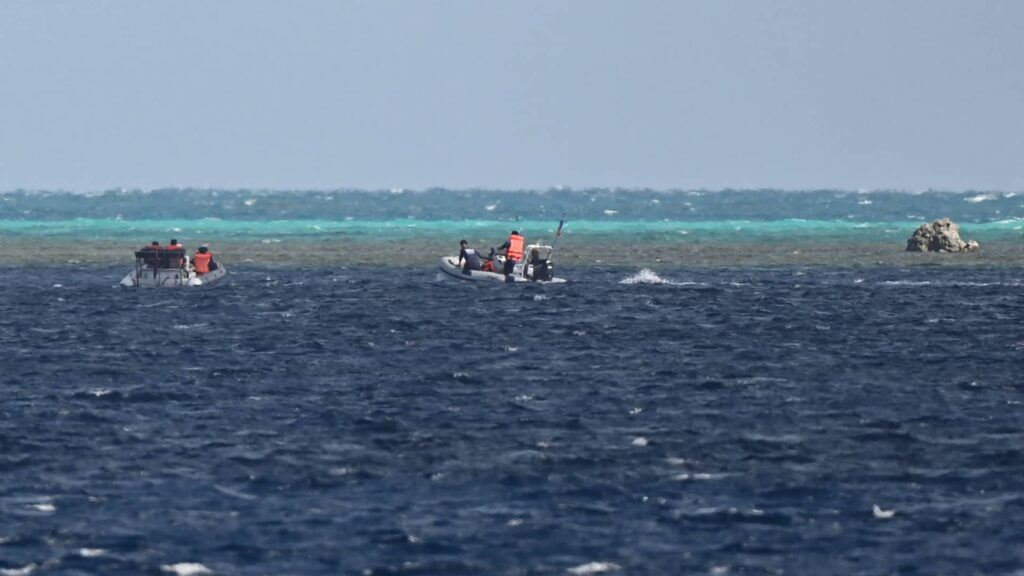This photo taken on February 16, 2024 shows Chinese Coast Guard personnel aboard their rigid inflatable boat (left) closely following another vessel (right) manned by Philippine Bureau of Fisheries and Aquatic Resources personnel from BRP Datu Tamblot as they attempt to enter the Scarborough Shoal area. Controlled by China (in background), in disputed waters in the South China Sea
Ted Algibi | AFP | Getty Images
Satellite images of the hotly contested Scarborough Shoal in the South China Sea show a new floating barrier at its entrance, near where Philippine ships and Chinese Coast Guard vessels have repeatedly clashed.
One image taken by Maxar Technologies on February 22 and seen by Reuters showed the barrier blocking the mouth of the shoal, where the Chinese coast guard last week claimed to have expelled a Filipino ship that had “illegally intruded” into Beijing's waters.
The Philippines, which last week deployed the Bureau of Fisheries and Aquatic Resources, or BFAR, to patrol the shoal and transport fuel to Filipino fishermen in the area, said China's claims were “inaccurate” and that Manila's activities there were legal.
China claims sovereignty over the Scarborough Shoal, even though it lies within the Philippines' 200-nautical-mile exclusive economic zone. An international arbitration court in The Hague said in 2016 that China's claims had no legal basis, a decision rejected by Beijing.
This makes the atoll one of the most contested maritime features in Asia and a flashpoint for diplomatic disputes over sovereignty and fishing rights.
The satellite image supports a report and video distributed by the Philippine Coast Guard, or PCG, on Sunday showing two Chinese Coast Guard inflatable boats deploying floating barriers at the entrance to the shoal on February 22.

PCG said a Chinese Coast Guard ship tracked the BFAR and “conducted obstruction maneuvers” about 1.3 nautical miles (2.4 km) off shallow waters, approaching it closely.
“We can assume that (the barrier) is for Philippine government ships because they install it every time they monitor our presence within the BDM,” said Jay Tarella, spokesman for the Philippine Coast Guard, referring to Bajo de Masinloc, Manila's port. Name for shallow water.
Chinese Foreign Ministry spokesman Mao Ning said that “Huangyan Dao,” as China gives the shallow waters, is “the inherent territory of China.”
“Recently, the Philippine side has taken a series of measures to violate China's sovereignty” in the shallow waters, she added. “China must take the necessary measures to vigorously protect its territorial sovereignty and maritime rights and interests,” he added.
Another satellite image showed what Maxar Technologies described as a “possible Chinese interception of a BFAR vessel” at Scarborough Shoal.
China claims almost the entire South China Sea, a corridor for more than $3 trillion in annual ship trade. Its territorial claims overlap with those of the Philippines, Vietnam, Malaysia, and Brunei.
“What we are seeing now in the Scarborough Shoal area is most likely the beginning of Beijing’s reaction against Manila’s reaction,” said Ian Storey, a senior fellow at the ISEAS-Yusof Ishak Institute in Singapore.
He said that since President Ferdinand Marcos Jr. took office in June 2022, the Philippines has challenged the Chinese presence in Scarborough and its attempts to stop the resupply of Filipino troops stationed at Second Thomas Shoal.
“China’s attempts to prevent Filipino fishermen from fishing at Scarborough Shoal are completely illegal,” Storey said. “The 2016 arbitration court ruling gave fishermen from both countries the right to (fish there). Manila only supports the legitimate rights of Filipino fishermen.”
The shallow waters are known for their abundant fish stocks and a stunning turquoise lagoon that provides a safe haven for ships during storms.
Tarella said the Chinese removed the barrier a few hours after the BFAR ship departed. It is not clear from the pictures how strong the barrier is and whether it will constitute an obstacle to larger warships.
In an article on Sunday, state media Global Times said that “the Philippines has unilaterally abused and subverted the foundation of Beijing's goodwill towards Manila” by allowing Filipino fishermen to operate nearby, by acting against China's sovereignty and jurisdiction.
“If such provocations continue, China may be forced to take more effective measures to control the situation,” the article said, citing experts.
